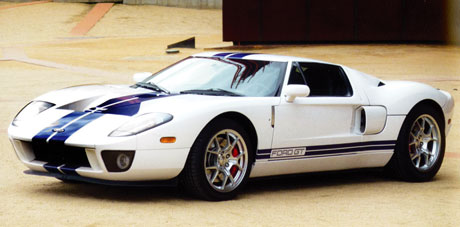SCM Analysis
Detailing
| Vehicle: | 2005 Ford GT |
| Years Produced: | 2005-06 |
| Number Produced: | 4,038 |
| Original List Price: | $149,995 |
| Tune Up Cost: | $850 |
| Engine Number Location: | Bar code sticker on valve cover |
| Club Info: | www.fordgt.org |
| Website: | http://www.fordgt.org |
| Investment Grade: | A |
This car sold for $187,128, including buyer’s premium, at the Bonhams & Goodman auction in Sydney, Australia, on December 6, 2009.
First came the 1998 Volkswagen New Beetle. Then it was the nuevo 2001 Mini. And then the 2005 Ford GT, the latest in a stirring lineup of nostalgia machines from major automakers-and certainly the most exciting. Conceived during the go-go 2000s and unlike the VW or Mini, the Ford GT was a bold low-production, high-performance apogee designed to harness Ford’s historic Le Mans racing heritage and stake out a place for FoMoCo at the top of the American sports car pecking order alongside the Viper, Corvette and Saleen.
Iconic shape still a traffic-stopper
Though dimensionally larger than the original racer, the modern Ford GT is commendably faithful to the original’s iconic shape, then as now a traffic-stopper. The roof height was even kept down to just 44.3 inches-nearly five inches lower than a Corvette C6 and not all that far from the original GT40’s celebrated 40-inch height. While magically styled and unsurpassed in its racing heritage, ironically the new Ford GT made little impact in contemporary racing, while modified street rivals including the Viper and Corvette excelled all the way up to the Le Mans level.
Like the exterior, the interior was well executed but hardly lavish-some would even call it cheap looking-though nicely ventilated deep bucket seats, a centrally mounted 220-mph speedometer, and a bank of racing-style toggle switches provided numerous talking points for owners while granting rides to friends.
Le Mans poseur or not, at the end of the day, Ford GT owners could also take delight in the fact that this car-while fundamentally an image-builder for Ford-was also a genuine performance demon. At 3,485 pounds, it was admittedly 277 pounds (9%) heavier than a standard Corvette C6, but its outstanding 550 hp and 500 ft-lb of torque evened the terms, and the Ford GT was able to surpass even the Corvette Z06’s track performance. (That would ultimately change as the supercharged ZR1 came into the Chevy fold with 638 hp and a curb weight of only 3,324 pounds.)
GT prices vs. Z06 prices
The 2005 Ford GT’s original MSRP was $149,995 (plus $5,350 for racing stripes, taking a page out of Porsche and Ferrari’s outlandishly priced options book). Collectors predictably snapped up the short run of 4,038 cars, no doubt thinking of future payoffs as collector car values in general spiraled into the ethersphere. The Ford GT production run was ended by the debut of new collision safety standards, which it did not meet.
Prices didn’t zoom to a million clams, but now, five years later, Ford GTs are doing a lot better than Corvette Z06s. While a first-year 2006 Z06 has lost a third of its value since new, as this Australian auction shows, the Ford GT has actually gained ground, with this example improving 25% over its original MSRP. In turbulent times that’s a comfort, and with some signs of economic recovery now appearing, perhaps the Ford GT has truly weathered the storm.
Regardless of whether you’re a bit above or below water in a Ford GT, it’s still a compelling car. The design is unmistakable and every bit as fetching as the original, even though, like an aging supermodel, the Ford GT is destined to rest on its laurels from the 1960s forever. Which is hardly a bad thing, when they’re such good ones. While the new Ford GT will never be a true classic, it will always be a well-done interpretation of Ford’s greatest race car, from Ford’s greatest era in racing.
As a thoughtful tribute to the original, let’s call this one intelligently, if a bit optimistically, bought.
